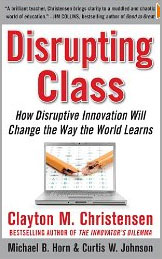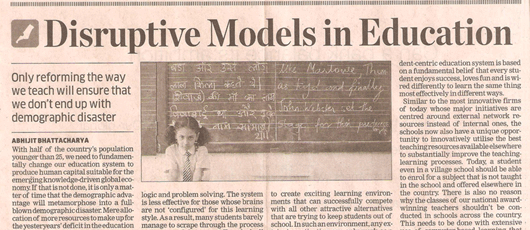DYNAMIND - WORLD AWAKENS
Extracts from book: (Emphasis on extracts are ours)
'Disrupting Class- How disruptive innovation will
change the way the World Learns'
Published in 2008 by Clayton M. Christensen
Bestselling author of The Innovator's Dilemma',
Michael B. Horn & Curtis W. Johnson.
Introduction
(Page 10)
Every student learns in a different way. This idea- that students have
different learning needs-is one of the cornerstones of this book. A
key step towards making school intrinsically motivating is to customize
an education to match the way each child best learns.
(Page 11)
In its most common manifestation, student-centric technology comprises a
computer with software, which can tailor itself to a student's specific
type of intelligence or learning style. An individual tutor would be another
type of student-centric technology. Monolithic technology, in contrast,
employs single instructional style for all students. A teacher lecturing
in classroom of students, all of whom use same textbook, is the most common
monolithic technology in education. But computers where software tries to
teach all students in the same way would also be monolithic technology.
Chapter 2: Making the Shift- Schools meet society's
needs
(Page 65)
And most products that the fragmented and marginally profitable educational
software industry has produced attempts to teach students in the same ways
that subject have been taught in the classroom.
Chapter 3: Crammed Computer Classrooms
(Page 82)
Cuban concluded, "In the end, both supporters and critics of school
technology (including researchers) have claimed that powerful software and
hardware often get used in limited ways to simply maintain rather than transform
prevailing instructional practices"
(Page 84)
Understanding how schools have spent so much money on computers only
to achieve such little gain isn't so hard. Schools have crammed the
computers into existing teaching and classroom models. Teachers have
implemented computers in the most common-sense way-to sustain their existing
practices and pedagogies rather than to displace them.
(Page 86)
By migrating instruction delivery to custom-configured vehicles able to
meet individual students' needs, schools can realize the dream of
transforming the classroom from a monolithic one into student-centric one
where all students can learn in the ways their individual minds are wired
to learn.
Chapter 4: Disruptively Deploying Computers
(Page 92)
Tutors today are largely limited to the wealthy; and for those privileged
few, good tutors come as close as possible to helping students learn each
subject in ways that match the way their brains are wired to learn. Like
all disruptions, student-centric technology will make it affordable, convenient,
and simple for many more students to learn in ways that are customized for
them.
(Page 98)
From 45,000 enrollments in fully online or blended-online courses in the
fall of 2000, that number had grown nearly 22 times to 1 million by the
fall of 2007. Roughly 70 percent of these were for high school students.
A significant 43 percent of rural schools already provide students with
access to online courses that would not otherwise be available. Even with
this rapid growth, however, online courses accounted for just 1 percent
of all courses in 2007. Not much change is on the horizon if one projects
linearly into the future. But when viewed from the logarithmic perspective,
the data suggests that by 2019, about 50 percent of high school courses
will be delivered online. In other words, within a few years, after
a long period of incubation, the world is likely to begin flipping rapidly
to student-centric online technology.
(Page 100)
Figure 4.2 suggests that the "flip" in the substitution curve
will begin in about 2012 - just four years from now. In the subsequent
six years, the technology's market share will grow from 5 percent
to 50 percent. It will become a massive market.
(Page 101)
In addition teachers will always remain in school, as we note in Chapter
1 - increasingly functioning as One-on-One tutors rather than teaching
monolithically-and computer-based and student-centric learning will enable
a teacher to oversee the work of more students.
(Page 107)
Instead of spending most of their time delivering one-size-fits-all lessons
year after year, teachers can spend much more of their time traveling from
student to student to help individuals with individual problems. Teachers
will act more as learning coaches and tutors to help students find the learning
approach that makes the most sense for them. They will mentor and motivate
them through the learning with the aid of real-time computer data on how
the student is learning. This means, however, that they will need very
different skills to add value in this future than the skills with which
education schools are equipping them today. Since customization will be
a major driver and benefit of this shift to student-centric online technology,
increasingly teachers will have to be able to understand differences in
students and be able to provide individual assistance that is complementary
to the learning model each student is using.
(Page 111)
When student learn through student-centric online technology, testing doesn't
have to be postponed until the end of an instructional module and then administered
in a batch mode. Rather, we can verify mastery continually to create right,
closed feedback loops.
Chapter 5: The System for Student-Centric Learning
(Page 134)
The tools of the software platform will make it so simple to develop online
learning products that students will be able to build products that help
them to teach other students. Parents will be able to assemble tools to
tutor their children. And teachers will be able to create tools to help
the different types of learners in their classrooms. These instructional
tools will look more like tutorial products than courseware. But rather
than being “pushed" into classrooms through a centralized selection
process, they will be pulled into use through self-diagnosis- by teachers,
parents and students.
(Page 137)
Notice that these sound more like tools for tutors-and that's the
point. We'd love for every student to be able to afford personal tutors
who have the skill to tailor the way they teach each subject to their students
in a manner that matches the way the student learn. But it's too expensive,
hence we've settled for monolithic instruction. These stage 2 tools
disrupt the tutoring business; they can make it so affordable and simple
that each student can have a virtual tutor through these tools. Over time,
the modules that students, parents and teachers employ to help students
solve individual learning problems in individual courses will be combined
into complete custom configured courses-the consummate purpose of modularity.

